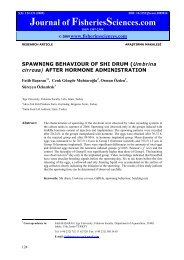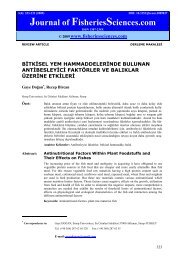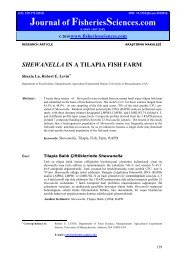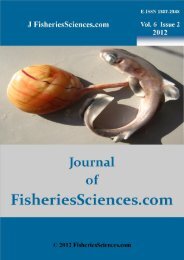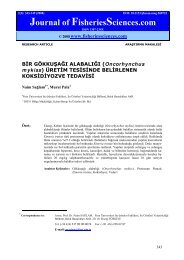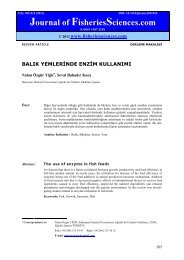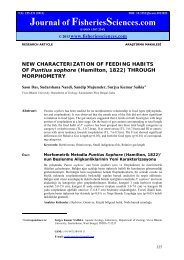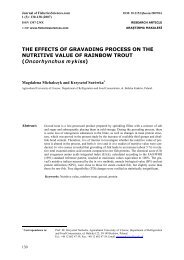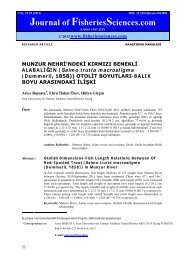ELEMENT COMPOSITIONS, FATTY ACID PROFILES, AND ...
ELEMENT COMPOSITIONS, FATTY ACID PROFILES, AND ...
ELEMENT COMPOSITIONS, FATTY ACID PROFILES, AND ...
You also want an ePaper? Increase the reach of your titles
YUMPU automatically turns print PDFs into web optimized ePapers that Google loves.
4(2): 177-183 (2010) DOI: 10.3153/jfscom.2010018<br />
Journal of FisheriesSciences.com<br />
E-ISSN 1307-234X<br />
© 2010 www.fisheriessciences.com<br />
RESEARCH ARTICLE ARAŞTIRMA MAKALESİ<br />
<strong>ELEMENT</strong> <strong>COMPOSITIONS</strong>, <strong>FATTY</strong> <strong>ACID</strong> <strong>PROFILES</strong>,<br />
<strong>AND</strong> PROXIMATE <strong>COMPOSITIONS</strong> OF MARBLED<br />
SPINEFOOT (Siganus rivulatus, Forsskal, 1775)<br />
and DUSKY SPINEFOOT (Siganus luridus, Ruppell,<br />
1878)<br />
Abdullah Öksüz ∗<br />
, Ayşe Özyılmaz, Hatice Sevimli<br />
University of Mustafa Kemal, Faculty of Fisheries and Aquaculture, Department of Fishing and Fish Processing Technology,<br />
Iskenderun-Turkey<br />
Abstract: Element compositions, fatty acid profiles, lipid levels, and proximate compositions of marbled<br />
spinefoot and dusky spinefoot from Northeastern Mediterranean Sea/Turkey were evaluated.<br />
Amounts of K and P of both fish were calculated as the predominant elements among the 11<br />
and followed by Na, Mg, and Ca in this study. Apart from the copper, micro elements<br />
composition did not change significantly in both species. Saturated fatty acids (SFA),<br />
polyunsaturated fatty acids (PUFA) and monounsaturated fatty acids (MUFA) levels were the<br />
predominant fatty acids in both species respectively. Linoleic (n6) acid and linolenic (n3) acid<br />
levels were significantly higher in dusky spine foot than marbled spine foot. The ratio of<br />
DHA/EPA in marbled spinefoot and dusky spinefoot were calculated as 3.58 and 1.82,<br />
respectively. Lipid content of dusky spine-foot was significantly (P< 0.05) higher than that of<br />
marbled spine-foot, although moisture contents of both fish were almost the same.<br />
Keywords: Siganus rivulatus, Siganus luridus, fatty acids, elements, Northeastern<br />
Mediterranean Sea<br />
∗ Correspondence to: Abdullah ÖKSÜZ, University of Mustafa Kemal, Faculty of Fisheries and Aquaculture,<br />
Department of Fishing and Fish Processing Technology, Iskenderun 31200 (Hatay)-TURKEY<br />
Tel: (+90 326) 6141693 Fax: (+ 90 326) 6141877<br />
E-mail: aoksuz@mku.edu.tr<br />
177
Journal of FisheriesSciences.com Öksüz et al., 4(2): 177-183 (2010)<br />
178<br />
Journal abbreviation: J FisheriesSciences.com<br />
Özet: Çarpan (Siganus rivulatus, Forsskal, 1775) ve Tavşan<br />
(Siganus luridus, Ruppell, 1878) Balıklarının Element<br />
Kompozisyonları, Yağ Asitleri Profilleri ve Besin<br />
Bileşenleri<br />
Introduction<br />
Kuzeydoğu Akdeniz bölgesinde bulunan çarpan ve tavşan balıklarının element<br />
komposizyonları, yağ asitleri profilleri ve besin bileşenleri incelenmiştir. Bu iki balığa ait K ve<br />
P seviyeleri incelenen 11 element içersinde en yüksek miktarlarda olduğu ve bunları sodyum,<br />
mağnezyum ve kalsiyum elementlerinin takip ettiği gözlenmiştir. Belirlenen mikro elementler<br />
içinde yalnız bakır miktarı önemli derecede tavşan balığında, çarpan balığından yüksek<br />
bulunmuştur. Her iki türde de en yüksek yağ asitleri doymuş yağ asitleri (SFA) olurken,<br />
bunları çoklu doymamış (PUFA) ve tekli doymamış yağ asitleri (MUFA) izlemiştir. Linoleik<br />
ve linolenik yağ asitleri tavşan balığında diğer türe göre daha yüksek bulunmuştur. Çarpan ve<br />
tavşan balığına ait DHA/EPA oranları sırası ile 3.58 ve 1.82 olarak hesaplanmıştır. Tavşan<br />
balığının yağ içeriği çarpan balığından önemli miktarda (P< 0.05) yüksek ve bu iki balığa ait<br />
nem miktarları ise hemen hemen aynı bulunmuştur.<br />
Anahtar Kelimeler: Siganus rivulatus, Siganus luridus, yağasitleri, elementler, Kuzeydoğu<br />
Akdeniz.<br />
Marbled spinefoot, light brown-olive, longitudinal<br />
yellow stripes on each side, and dusky spinefoot,<br />
body changes from mottled olive-green to<br />
dark brown at death (Torcu and Mater, 2000) are<br />
two successful lessepsian migrant fish species.<br />
These two species draw attention and are considered<br />
to be economically important (Torcu and<br />
Mater, 2000) fish species due to its delicious<br />
taste, considerably low fat content and affordable<br />
prize comparing other fish species with very<br />
similar visual attributes.<br />
Containing most of the 90 naturally occurring<br />
elements, fish are good sources of elements. The<br />
greater portion their body consist of carbon, hydrogen,<br />
nitrogen, oxygen and sulphur. In addition,<br />
six macro elements (calcium, magnesium,<br />
phosphorus, sodium, potassium, and chlorine) are<br />
present in gram per kilogram quantities. The remaining<br />
elements occur in the body in much<br />
lower concentrations (mg or per kg) and called<br />
microelements (trace elements; iron, zinc, copper,<br />
manganese, iodine, cobalt, nickel, molybdenum,<br />
chromium, fluorine, etc) (Lall, 1995). Macro<br />
elements are required in our diets in amounts<br />
greater than 100 mg, and the microelements are<br />
required in milligram quantities or less per day<br />
(Nabrzyski, 2002).<br />
Fish is generally consumed in almost every<br />
part of the world, whether which has a way to the<br />
water or not, by humans because it has high protein<br />
content, low saturated fat and also contains<br />
omega fatty acids known to support good health<br />
in very different ways. This fact has been subjected<br />
to many studies and described well enough<br />
in too many articles. That is why it is not be detailed<br />
these beneficial here.<br />
Though two commercially important lessepsian<br />
migrant species, marbled spinefoot and<br />
dusky spinefoot belonging to same family in the<br />
Northeastern Mediterranean Sea/Turkey, are<br />
found in the Mediterranean and consumed along<br />
the region, limited information are available<br />
about them. The aims of this present study were<br />
to search mineral contents, fatty acid profiles, and<br />
proximate compositions of marbled spinefoot and<br />
dusky spinefoot and also to find out differences<br />
between the two species.<br />
Materials and Methods<br />
Materials<br />
Both dusky spinefoot and marbled spinefoot<br />
were captured by a local fisherman in the coast of<br />
Iskenderun Bay (Northeastern Mediterranean<br />
Sea/Turkey). The samples were obtained in<br />
March 2008 and analysis was carried out as soon<br />
as samples were received.<br />
Sample preparation<br />
After transferring the fish to the laboratory,<br />
they were gutted, filleted, and minced. The samples<br />
were minced using with a laboratory type<br />
blender. Sampling was done in triplicate for each<br />
group.
Journal of FisheriesSciences.com Öksüz et al., 4(2): 177-183 (2010)<br />
Determination of lipid, moisture, and ash content<br />
EEC recommended oven drying method ISOR<br />
1442 (Commission of European Communities<br />
EC, 1979), modified Bligh & Dyer Method<br />
(Hanson & Olley, 1963), and A.O.A.C., 35.1.14<br />
(2000) method no 938.08 were used to determine<br />
the moisture, crude lipid, and ash content of both<br />
fish species, respectively.<br />
Fatty acid methylester (FAME’s) and mineral<br />
analysis<br />
Separation of FAMEs was carried out as described<br />
in Oksuz et al. (2009). Fatty acid methyl<br />
ester of fish lipid was injected to Hewlett Packard<br />
HP 6890 series GC coupled with HP 6890 Mass<br />
Selective Detector. Injector was set to automatic<br />
mode and injection volume was 2 micro litres on<br />
split mode with a split ratio of 1/50. Separation<br />
of total fatty acids was achieved in 31 minutes.<br />
The identification of individual fatty acids was<br />
carried out by comparing those retention time of<br />
FAME standard (Supelco 47085U PUFA No: 3)<br />
and Supelco 37 component Fame mix (47885-U).<br />
Confirmation of FAME was also performed by<br />
using a MS data base library (FAMEDBWAX).<br />
Extraction and determination of mineral elements<br />
The wet ashing method was used for digestion<br />
of organic matter. This procedure was carried out<br />
according to (AOAC Method 975.03) with a minor<br />
modification. Fish flesh (2 g) was weighted<br />
into a polypropylene screw capped tube and 10<br />
ml of 65% HNO3 (Merck, Darmstadt, Germany)<br />
were added to the sample, followed by the addition<br />
of 3 ml of 60 % perchloric acid (Merck,<br />
Darmstadt, Germany). Samples were left overnight<br />
to complete digestion. Further heating was<br />
then carried out in a hot water bath at 90 ° C for 6<br />
hours. Digests were filtered into a 25 ml volumetric<br />
flask, using ash-free filter paper and made up<br />
to 25 ml the volume with ultra pure water.<br />
The determination and quantification of mineral<br />
elements were done by ICP-AES (Varian<br />
Model- Liberty series II). Calibration curves for<br />
each of the individual elements were prepared<br />
from ICP Multi element stocks (Charleston, SC<br />
29423). The phosphorus standard solution was<br />
prepared by dissolving KH2PO4 (Merck) in ultra<br />
pure water to obtain a 1000-ppm stock phosphorus<br />
standard. The standard stock solution was<br />
then acidified (100 µl/100 ml) with 65% HNO3.<br />
Journal abbreviation: J FisheriesSciences.com<br />
Statistical analysis<br />
Data were subjected to analysis of variance<br />
(ANOVA) and mean comparison was carried out<br />
using Duncan’s test. Statistical analysis was performed<br />
with SPSS 15.0. Significance was established<br />
at P0.05).<br />
Spawning season of both marbled spinefoot<br />
and dusky spinefoot are supposed to be from<br />
April to August in the Mediterranean (Torcu and<br />
Mater, 2000). Therefore, both of the fish were<br />
supposed to be out of spawning period since they<br />
were caught in March.<br />
Table 1. Lipid, moisture, and ash contents of<br />
dusky spinefoot and marbled<br />
spinefoot<br />
Components Dusky Marbled<br />
(%)<br />
spinefoot spinefoot<br />
Lipid 3.31±0.09 a 2.37±0.08 b<br />
Moisture 78.8±1.4 a 78.0±1.0 a<br />
Ash 1.65±0.13 a 1.56±0.13 a<br />
Means ± SD (n=3) within the same row that have different<br />
letter is significantly different (P
Journal of FisheriesSciences.com Öksüz et al., 4(2): 177-183 (2010)<br />
Fatty acid (FA) composition<br />
The FA composition of dusky spinefoot and<br />
marbled spinefoot are shown in Table 2. A total<br />
of 20 FA for both fish species were identified in<br />
this study. The determination of the fatty acid<br />
compositions of dusky spinefoot and marbled<br />
spinefoot were performed by GC-MS. The composition<br />
of saturated (SFA), monounsaturated<br />
(MUFA), and polyunsaturated fatty acid (PUFA)<br />
of dusky spinefoot were found to be 38.62%,<br />
26.15%, and 35.23%, while those of marbled spinefoot<br />
were found to be 45.76%, 22.94%, and<br />
31.18%, respectively. The SFA levels in marbled<br />
spinefoot were found higher than that of dusky<br />
spinefoot whereas the MUFA and PUFA level of<br />
marbled spinefoot were present in low levels.<br />
The major FA identified in both fish species were<br />
palmitic acid (C16:0), oleic acid (C18:1 n9), palmitoleic<br />
acid (C16:1 n7), arachidonic acid (C20:4 n6,<br />
ARA), docosahexaenoic acid (C22:6 n3, DHA),<br />
and eicosapentaenoic acid (C20:5 n3, EPA).<br />
The SFA levels of dusky spinefoot and marbled<br />
spinefoot were found to be the highest<br />
among all fatty acids. This result may be<br />
attributed to the effect of fish digestion. The<br />
average level of C16:0 in marbled spinefoot<br />
(32.64%) was found to be higher than that in<br />
dusky spinefoot (28.20%). Similar results were<br />
noted in the terms of C16:0 for muscle of Siganus<br />
fuscescens, another spinefoot species, by Osako<br />
et al., (2006) and the level of Siganus luridus (the<br />
same fish species studied in this study) in March<br />
by Saoud et al., (2007). The levels of stearic acid<br />
(C18:0) and C14:0 in both fish species were found to<br />
be very close to each other (P>0.05). The rest of<br />
the SFA components in both fish species were in<br />
lower amounts.<br />
The MUFA component of both fish species in<br />
this present study were differed from each other.<br />
These differentiation were found statistically not<br />
significant (P>0.05). The level of C18:1n9 and<br />
C16:1 n7 were the predominant fatty acid in edible<br />
part dusky spinefoot and marbled spinefoot. The<br />
amount of C18:1 n9 in marbled spinefoot was<br />
found higher than that of dusky spinefoot with<br />
the values of 16.17% and 15.80%, respectively.<br />
Osako et al., (2006) reported that the level of<br />
C18:1 n9 in muscle of Siganus fuscescens was<br />
found to be 11.7% in March which is the same<br />
month that both fish species caught in. The value<br />
of C18:1 n9 is lower than that of both fish species<br />
in this study. However, the level of C18:1 n9 in<br />
180<br />
Journal abbreviation: J FisheriesSciences.com<br />
muscle of Siganus fuscescens in May (Osako et<br />
al., 2006) was found exactly the same as that of<br />
C18:1 n9 in dusky spinefoot in March in this study.<br />
The PUFA level of dusky spinefoot was found<br />
to be higher than that of marbled spinefoot<br />
(P>0.05).The DHA in both fish species was calculated<br />
as the highest percentages in all PUFA<br />
content. Osako et al., (2006) and Saoud et al.,<br />
(2007) were reported similar result for Siganus<br />
fuscescens and Siganus luridus, respectively. Additionally,<br />
the level of EPA in dusky spinefoot<br />
was found to be statistically higher than that of<br />
marbled spinefoot with the value of 4.34% and<br />
2.36%, respectively (P
Journal of FisheriesSciences.com Öksüz et al., 4(2): 177-183 (2010)<br />
The levels of ARA in both fish species were<br />
found surprisingly higher than those of EPA. In<br />
addition, the level of ARA was calculated as<br />
5.96% and 7.42% for dusky spinefoot and marbled<br />
spinefoot in this study, respectively<br />
(P0.05) differences were noted in the rest of the<br />
element contents studied in this research.<br />
Almost no Cd, a toxic element, was determined<br />
in both fish species in this study. This is a<br />
good sign for a raw food material. In addition, the<br />
average level of Cr (chromium) marbled spinefoot<br />
was found to be 0.30±0.10 mg/kg. Even<br />
though this value is found a little bit higher than<br />
that previously determined for muscle of Siganus<br />
rivulatus from the coastal waters of EL-max Bay<br />
by (Abdallah, 2008), it is still in a very low<br />
amounts. On the other hand, the level of Cr dusky<br />
Journal abbreviation: J FisheriesSciences.com<br />
spinefoot was found to be 0.09±0.07 mg/kg<br />
which is lower than that of marbled spinefoot in<br />
this study and that reported by (Abdallah, 2008)<br />
for the same fish species.<br />
The level of Mn calculated in both fish species<br />
in this study are the same with each other.<br />
This value is lower than in muscle of Siganus rivulatus<br />
from three different locations (Kress et<br />
al., 1999). In addition, the amount of Cu and Zn<br />
(zinc) in flesh of marbled spinefoot and dusky<br />
spinefoot in this study differed from each other.<br />
However, only the levels of Cu between two species<br />
were found statistically significant (P<<br />
0.05). The levels of Cu and Zn in muscle of marbled<br />
spinefoot were found higher than dusky spinefoot<br />
in this research. These finding are far below<br />
previously determined in both of the same<br />
fish species by (Abdallah, 2008). According to<br />
Kress et al., (1999) the levels of Cu and Zn in<br />
muscle of marbled spinefoot at Haifa Bay were<br />
reported similar to those determined in the current<br />
study.<br />
The level of Fe (iron) in muscle of marbled<br />
spinefoot (8.65 mg/kg) was found lower than<br />
dusky spinefoot (9.66 mg/kg) in this research.<br />
Compared to Kress et al., (1999) findings, the<br />
levels of Fe in muscle of marbled spinefoot at<br />
Ardag and Observatory were found higher than<br />
our finding. Fe is one of the essential trace elements<br />
and should be in daily diet. Fe supplied in<br />
the diet must be in the range of 15 mg/day in order<br />
to meet daily requirement (Belitz et al.,<br />
2004).<br />
The levels of K (potassium) and P (phosphorus)<br />
in the edible portion of marbled spinefoot<br />
and dusky spinefoot were the most abundant<br />
minerals, followed by Na (sodium), Mg (magnesium)<br />
and Ca (calcium). The amounts of K and P<br />
in the flesh of dusky spinefoot (2880 and 2331<br />
mg/kg, respectively) were found to be higher<br />
than those in the flesh of marbled spinefoot (2683<br />
and 2183 mg/kg, respectively) (P>0.05). In addition,<br />
fish are a good source of P (Lall, 1995),<br />
which is directly involved in energy-producing<br />
cellular reactions. On the other hands, K regulates<br />
the osmotic pressure within the cell, is involved<br />
cell membrane transport, and activation of<br />
some enzymes (Belitz et al., 2004).<br />
Although the quantity of Mg in the muscle of<br />
dusky spinefoot was found to be higher than that<br />
of Mg in muscle of marbled spinefoot with values<br />
of 506 and 393 mg/kg, respectively, the dif-<br />
181
Journal of FisheriesSciences.com Öksüz et al., 4(2): 177-183 (2010)<br />
ference between two fish was not statistically<br />
significant (P>0.05). Even though Mg toxicity is<br />
rare, an adequate intake of magnesium has some<br />
useful roles in a human body due to the fact that<br />
it provides nutrition, regulates enzyme systems,<br />
helps to maintain bone health, is required for<br />
energy metabolism, and acts as a part of the protein-making<br />
machinery in all cells of soft tissues<br />
(Whithney & Rolfes, 2008).<br />
Table 3. Mineral compositions (mg/kg, wet<br />
weight base) of dusky spinefoot and<br />
marbled spinefoot<br />
Minerals<br />
182<br />
Dusky<br />
Spinefoot<br />
Journal abbreviation: J FisheriesSciences.com<br />
Marbled<br />
spinefoot<br />
Cd 0.00±0.00 a 0.00±0,00 a<br />
Cr 0.09±0.07 a 0.17±0.16 a<br />
Cu 0.08±0.04 a 0.30±0.10 b<br />
Mn 0.12±0.05 a 0.12±0.02 a<br />
Zn 5.67±0.56 a 6.02±0.61 a<br />
Fe 9.66±4.09 a 8.65±4.88 a<br />
Ca 382.89±131.74 a 416.81±71.61 a<br />
Mg 506.35±17.17 a 392.90±97.09 a<br />
Na 687.35±66.52 a 729.62±328.50 a<br />
P 2331.71±73.85 a 2183.61±183.36 a<br />
K 2880.14±57.66 a 2683.24±370.31 a<br />
Mean ± SD (n = 5) with different letter in the same<br />
row is significantly different.<br />
Level of significance (p < 0.05).<br />
The amount of Ca in marbled spinefoot (417<br />
mg/kg) was found to be higher than that in dusky<br />
spinefoot (383 mg/kg) (P> 0.05). Ca is an essential<br />
mineral which must be added to diet. The<br />
amount of recommendation for Ca is (RDA) 800<br />
mg/day. Ca involves in the structure of the muscular<br />
system and controls essential process like<br />
blood clotting, activity of brain cells and growth<br />
(Belitz et al., 2004).<br />
The level of Na in the edible part of marbled<br />
spinefoot and dusky spinefoot was found to be<br />
730 and 687 mg/kg, respectively. In addition, no<br />
significant (P
Journal of FisheriesSciences.com Öksüz et al., 4(2): 177-183 (2010)<br />
Nabrzyski, M. (2002). Mineral Components and<br />
functional properties of food components,<br />
Sikorski, Z. E., CRC Press, Florida, chapter.<br />
4.<br />
Öksuz, A., Özyılmaz, A., Aktas, A., Gercek, G.,<br />
Motte, J., (2009) A Comparative Study on<br />
Proximate, Mineral and Fatty Acid Compositons<br />
of Deep Seawater Rose Shrimp (Parapenaeus<br />
longirostris, Lucas 1846) and<br />
golden Shrimp (Plesionika martia, A.<br />
Milne-Edwards, 1883), Journal of Animal<br />
and Veterinary Advances, 8(1): 183-189.<br />
Osako, K., Saito, H., Kuwahara, K., Okamoto, A.<br />
(2006). Year-round high arachidonic acid<br />
levels in herbivorous rabbit fish Siganus fuscescens<br />
tissues Lipids by AOCS Press, 41<br />
(5): 473-489.<br />
Saoud, P. I., Batal, M., Ghanawil, J., Lebbos, N.<br />
(2007). Seasonal variation in highly unsatu-<br />
Journal abbreviation: J FisheriesSciences.com<br />
rated fatty acid composition of muscle tissue<br />
of two fish endemic to the eastern Mediterranean,<br />
Ecology of Food and Nutrition, 46:<br />
77-89. doi:10.1080/03670240701282456<br />
Saoud, P. I., Batal, M., Ghanawil, J., Lebbos, N.<br />
(2008). Seasonal evaluation of nutritional<br />
benefits of two fish species in the eastern<br />
Mediterranean Sea. International Journal of<br />
Food Science and Technology, 43: 538-542.<br />
doi:10.1111/j.1365-2621.2006.01491.x<br />
Torcu, H., Mater S. (2000). Lessepsian fishes<br />
spreading along the coasts of the Mediterranean<br />
and the Southern Aegean Sea of Turkey,<br />
Turkish Journal of Zoology, 24: 139-<br />
148.<br />
Whithney, E., Rolfes, S. R. (2008). Understanding<br />
nutrition (11 th ed.). West Publishing<br />
Company, MN (USA), pp. 410.<br />
183



